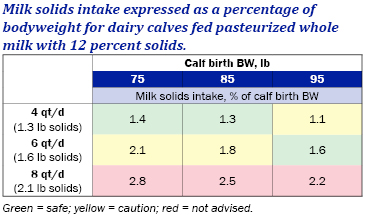
Accurately Tracking Growth and Performance of Young Calves – Dr. Noah Litherland, Vita Plus
 By Dr. Noah Litherland, Vita Plus dairy youngstock technical specialist
By Dr. Noah Litherland, Vita Plus dairy youngstock technical specialistFive key metrics can help us evaluate calf performance. They are:
- Birth bodyweight
- Gestation length, calving ease score, calving outside the calving pen, twinning, and failure of passive transfer
- Health treatment and age at treatment
- Age, weight and hip height at weaning/grouping
- Weight at three months and at six months
What these measurements tell us:
1. Birth bodyweight
This is the starting point for determining the calf’s maintenance requirements and, therefore, how much milk we should feed to calves. I have tracked birth bodyweights on a number of farms throughout the Midwest. On average, a Holstein heifer calf weighs 85 pounds. Based on this bodyweight, we can develop a general rule for a milk feeding program where calves weighing less than 85 pounds at birth should not be fed much more than 4 quarts of whole milk per day for the first week of life. Calves greater than 85 pounds should probably consume closer to 6 quarts of milk during the same time.
 This simple guideline uses the amount of energy a calf needs for maintenance. Large calves need more energy to maintain their larger frames, while the opposite is true for smaller calves. Additionally, intake as a percent of bodyweight is an often-overlooked concept for calves.Let’s do an example and take a look at Table 1.
This simple guideline uses the amount of energy a calf needs for maintenance. Large calves need more energy to maintain their larger frames, while the opposite is true for smaller calves. Additionally, intake as a percent of bodyweight is an often-overlooked concept for calves.Let’s do an example and take a look at Table 1.
A 4-quart-per-day feeding rate is reasonable for the 75-pound calf and the 85-pound calf, but is modestly low for the 95-pound calf. A 6-quarts-per-day feeding rate is on the high side for a 75- and 85-pound calf, but is about right for a 95-pound calf. An 8-quart feeding rate is probably too much for any of the calves in our example.
The take-home message: Bodyweights can help set up a simple feeding program using the 85-pound calf as the cut off between starting calves at a 2- or 3-quart-per-feeding rate. Feeding the right amount of milk in the first week has an incredibly large impact on the rest of the nursery phase, so it is important to get feeding rates right at the beginning.
2. Gestation length, calving ease score, calving outside the calving pen, twinning, and failure of passive transfer (serum total protein below 5.2)
All of these factors impact calf vigor. Calves are considered high risk when a short gestation length, calving in compromised conditions, dystocia or twinning occurs. High-risk calves can potentially act as disease carriers and put other calves at risk, so isolating these calves has merit.
Individually, these factors are important, but have a greater impact when any of these factors are combined.For example, a calf that is born early (not fully developed) and born in unsanitary environment outside of the calving pen has two strikes against her and is going to need additional supportive therapy.
3. Health treatment and age at treatment
Calves that are treated for scours and successfully recover do not typically seem to have long-term reductions in growth during the nursery phase. Calves with pneumonia treatment, however, do typically have lower rates of growth. These calves may need to be held back in hutches to allow them to gain more weight so they are more competitive in group settings.
4. Age, weight and hip height at weaning/grouping
When combined with birth bodyweight, age and weight at weaning allows for calculation of total gain and average dairy gain (ADG). We believe growth is an expression of health and welfare. Without adequate health and welfare, calves do not reach their potential for growth.
We consider ADG of 1.8 pounds per day and greater through 60 days of age to be exceptional. An ADG less than 1.4 pounds per day indicates clear opportunities for improvement. Doubling birth bodyweight in 60 days for an 85-pound calf is a 1.4-pounds-per-day ADG.This growth rate results in a calf weighing 170 pounds at two months of age.
5. Weight at three months and at six months
A three-month weight gives an indication of how well calves transitioned from the nursery phase to the grouping/grower phase. Calves should enter the grower phase at a minimum of 170 pounds, maintaining a growth rate of at least 1.7 pounds per day and weighing a minimum of 220 pounds by three months of age.
A six-month weight gives an indication of how well calves have transitioned onto a TMR and into larger groups. Maintain a 1.8 pounds-per-day growth rate from 3 to 6 months with a minimum weight of 380 pounds at six months of age. Calves should gain in both weight and height.
| Category: |
Animal health Starting Strong - Calf Care |

